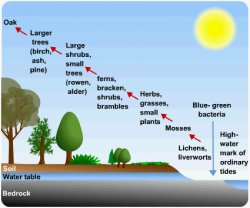Types of ecological succession
 The route to climatic climax can take place in two ways as shown below:
The route to climatic climax can take place in two ways as shown below:
Primary succession is found on a new land surface or in water and various seral stages are passed through before climatic climax is reached. It is an orderly sequence of events where one community is replaced by another. Biomass is created via decomposition and provides more nutrients for the soil allowing for greater and variety of plants and animals to exist at each successive seral stage:
Formation of a primary succession (lithosere):
A Bare rock colonised, by pioneer community, for example, lichens, mosses, bacteria, that can survive in hardy conditions, and need few nutrients. Rock slowly weathered creating thin soil.
C
Plants die, creating humus, leading to a more fertile soil, grasses replace the mosses and lichens as the dominant species.
Grasses decrease in number, quick-growing shrubs become dominant.
E
Fast growing trees dominate.
Over time slower growing trees such as oak become dominant and form the climatic climax community.
Rock slowly weathered creating thin soil.
C
Plants die, creating humus, leading to a more fertile soil, grasses replace the mosses and lichens as the dominant species.
Grasses decrease in number, quick-growing shrubs become dominant.
E
Fast growing trees dominate.
Over time slower growing trees such as oak become dominant and form the climatic climax community.
 Other examples of primary succession include:
Other examples of primary succession include:
- Haloseres - (salt marshes/estuaries).
- Psammoseres (sand dunes).
- Hydroseres (lakes).
If plant succession is halted before reaching dynamic equilibrium a secondary succession occurs. Interruptions include fire, disease, climate change and deforestation. These events can also alter the final climax community that result. Both primary and secondary succession are shown below:
Rooted plants increase the sedimentation and nutrients available. They alter the micro-environment so that reeds, fen, carr and oak are increasingly able to tolerate the thickening and drying soil.

